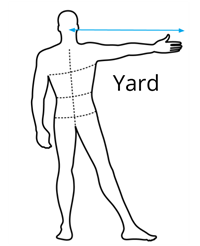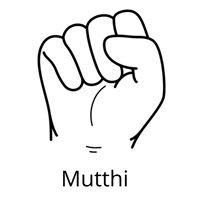PDF chapter test TRY NOW
Traditional units
It is evident from the excavations of the Indus valley civilisation that people had good knowledge about measurement.
In ancient Egypt and Rome, units like cubit and yard were in practice, respectively.
A cubit is a measure of length from elbow to tip of finger, whereas, a yard is the distance between the end of the outstretched arm and the chin.
Example:
Even today, we can notice that garland sellers use cubit for measuring flowers, and, yard is used for measuring cloths.


In ancient India, people used angul (finger) or a mutthi (fist) as units for small measurements.


In all these methods, people used their body parts like hand or foot for measuring length. But, it was inconsistent and lacked uniformity since it varies from person to person.
To attain uniformity in measurement, French scientists created a standard unit of measurement called the metric system. Nowadays, the International System of Units (SI units) is used as a standard unit.
Length
Length, in general, is the measurement of distance. The SI unit of length is a metre (m).
Units of length
One metre (m) is divided into 100 equal parts called centimetre (cm).
1 m = 100 cm
One centimetre (cm) has 10 equal parts called millimetre (mm).
1 cm = 10 mm
For measuring longer distances, we use a larger unit of length called, kilometre (km).
1 km = 1000 m
Measuring the length of an object
In general, we use a metre scale or rod to measure length.
1. Take the metre scale and keep it along with the length of the box to measure.

One should never slide the scale across the box as it will produce an incorrect reading.

2. Check the markings of the scale. If the end of the scale (0\ cm) is broken, then we should consider the next marking of the scale (say, 1.0\ cm) as one reading and measure the length.

Here, the reading at one end is 1.0\ cm, and the reading at other end is 12.0\ cm then, we should subtract the two readings. Now, the correct reading is 11.0\ cm.
3. Also, the position of the eye plays an important role in measurements. The eye should be placed vertically above the point where the measurement has to be taken. If you view from either side of the vertical position, then the readings will be viewed differently.

Steps to measure a curved line
Length of a curved line can be found using a thread.

1. Tie a knot at one end and place it along the curved line.
2. Now, mark the points where the curved line starts (A) and ends (B) on the thread.
3. Then, keep the thread on the metre scale and measure the length between the marks of the thread. Thus, the length of a curved line is measured.
Reference:
https://media.cheggcdn.com/study/5b1/5b185b8a-9b14-4fde-a78e-4d2660c7272e/202573-10.1-16IPS1.png
https://www.ekshiksha.org.in/chapter/54/images_of_Motion_and_Measurement_of_Distances_VI/8.png
https://i.redd.it/e8z5sqfgsoz11.jpg
https://www.ekshiksha.org.in/chapter/54/images_of_Motion_and_Measurement_of_Distances_VI/7.png
https://miro.medium.com/max/2116/1*xHnkSecupuspX8WaNlYh3A.jpeg
https://www.ekshiksha.org.in/chapter/54/images_of_Motion_and_Measurement_of_Distances_VI/8.png
https://i.redd.it/e8z5sqfgsoz11.jpg
https://www.ekshiksha.org.in/chapter/54/images_of_Motion_and_Measurement_of_Distances_VI/7.png
https://miro.medium.com/max/2116/1*xHnkSecupuspX8WaNlYh3A.jpeg
https://encrypted-tbn0.gstatic.com/images?q=tbn%3AANd9GcS9abCoMbdDdsG3XnKKV6O1BKSI3o6rLc6mgg&usqp=CAU
